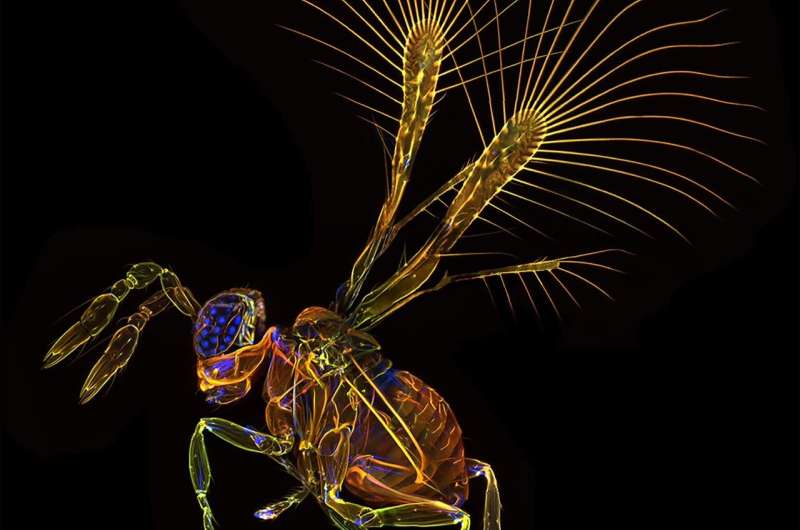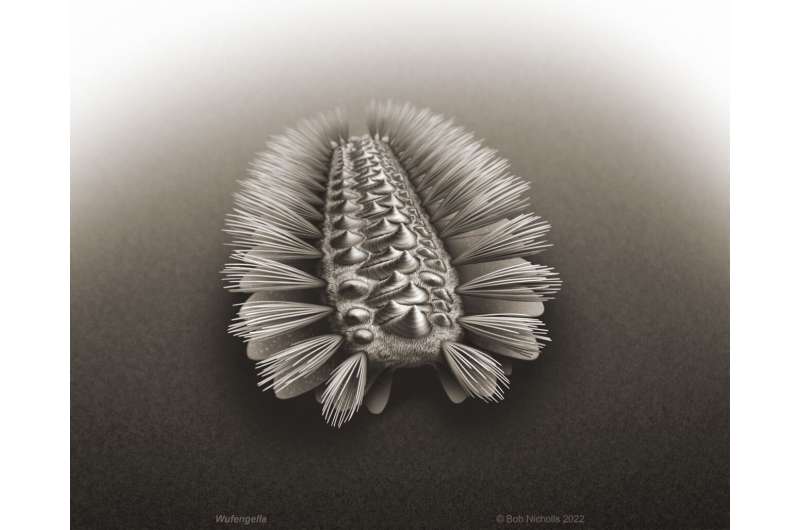Credit: Natural History Museum
From research trips to remote locations, to combing through the 80 million objects held in the Museum collections, each year scientists are adding to this extensive library of life. While many of these species will already be known to those who live alongside them, by giving them scientific names we can hopefully better protect them.
As most animals on Earth are invertebrates (animals without a backbone) it is not surprising that the majority of new species described this year fall into this group.
This has included some 84 species of beetle, 34 species of moths, 23 species of moss animals (also known as bryozoans) and 13 species of trematode worms. There were also 12 new species of protists, seven species of flies, two bumblebees from Asia, two polychaete worms from the depths of the oceans and a centipede with a number of segments that has never been seen by scientists before.
But the group that gained the most new species this year is the wasps. A total of 85 new species were described! This includes some miniature individuals with the most beautiful, feather-like wings. These tiny animals belong to a group containing some of the smallest insects in the world.
Despite their diminutive size, these parasitic wasps might be important for agriculture. The insects parasitise the eggs of thrips (a type of insect that can cause crop damage) and as such the wasps may be important biological control agents.
Dr. Gavin Broad is the Principal Curator in Charge of Insects at the Museum and an expert in Hymenoptera, the group that contains wasps.
"It's no surprise that new wasp species came out on top, it's just a surprise that wasps don't come top every year," explains Gavin. "The abundance of parasitoid wasps makes the order Hymenoptera the most species-rich order of insects, but its is way behind some other groups in terms of actual species descriptions."
"Watch out for lots more wasps next year!"
This year also has seen 19 new species of stick insects described. All of these hailed from the tropics of Australia and required the researchers to use newly collected insects, museum specimens and genetic analysis to reveal that what was originally thought to be 11 species were actually 30.
A handful of vertebrates have also been described by Museum scientists, including a new species of gecko from the Seychelles, three species of fish and seven species of frogs.
Six of these frogs are some of the smallest known vertebrates. Found living in the leaf litter of Mexico, the frogs grow to just eight millimeters in length, which is smaller than a 1p coin. Why these frogs have evolved to be so small is not yet understood.
Credit: Natural History Museum
Scientists have not only been describing the living this year, but also the dead with three new species of dinosaurs named. Two are armored dinosaurs from China. The first of these is the oldest and most complete armored dinosaur found in Asia, while the other is the oldest ever stegosaur. Together, the two species are helping researchers better understand how the heavily armored group evolved.
The third new dinosaur described this year is a carnivorous species with tiny arms, found in northern Argentina. Dating to 70 million years old, it is giving clues as to how this part of the world responded to the asteroid that wiped the dinosaurs out.
It isn't only dinosaur fossils that are helping researchers better understand the past. A 200-million-year-old fossil lizard that was hiding in the collections turned out not only to be a new species, but also the oldest lizard known to science, pushing the origins of this group back by up to 30 million years.
Also in the collections was a fearsome crocodile-like predator, originally unearthed some five decades ago, that would have stalked what is now Tanzania during the Triassic Period.
Researchers have also been busy describing eight new species of ancient mammals, known mainly from their teeth. Two of these new species would have been darting around the undergrowth and along the branches above the heads of dinosaurs during the Middle Jurassic. The six other new species are early representatives of the group that contains our own primate relatives and would have been living in what is now the Isle of Wight some 35 million years ago.
One of the most interesting fossil finds this year is a tiny beetle trapped in Ukrainian amber also dating to 35 million years ago. Known as a toe-winged beetle, this particular group of insects is now only found in the tropics and subtropics, with the fossil beetle revealing that the climate in Ukraine must have been much milder when the insect was alive during the Late Eocene.
The new fossil beetle was described by an international team of researchers from the Czech Republic, Latvia, Russia, Ukraine and the United Kingdom as a show of international collaboration in the face of the ongoing war in Ukraine.
"We considered it important to stay together to assist one another and achieve best possible result as a team, despite the present situation," explains Dr. Dmitry Telnov, a Curator of beetles at the Museum. "With this discovery we do not sort or judge any colleagues, but send a clear message to the scientific community that staying united and supporting one another is how the war can be finished."
Credit: Natural History Museum
There have been a couple of new species of fossil fish, plus a slightly unusual new species named after the trace fossil of a Jurassic ghost shark egg case. Staying in the oceans, there have been three new species of trilobites, four new species of sea scorpions and a curious armored worm that has filled a major gap in the fossil record.
Finally, three new species of minerals were described this year, including one with brittle translucent blue crystals called Bridgesite that was discovered in Cumbria, United Kingdom.
Many plants and algae also made the list. Researchers described a total of 11 new species of algae this year, both fossil and living, while four new species of plants were described from across southern Asia, including one from Sulawesi that's covered in rather fearsome looking spines.
Dr. Sandra Knapp is a Merit Researcher at the Museum and was involved with the description of these new plant species.
"Although flowering plants are relatively well known as far as groups of organisms go, it is estimated that even though we have given about 450,000 species scientific names, there are about 25% of that left to describe. Not to discover—for sure, these things we don't know about are known by local and Indigenous peoples where they occur—we taxonomists just give them names that put them into the language of global botany."
"Most plants have a variety of names, some specific to an area or language group, others more widespread, but the scientific names we coin can be used by anyone anywhere. This means there is a common language, one of the things we really need to help bend the curve for biodiversity."
"After all, if we can't talk about a species, how can we wish to save it?"
Provided by Natural History Museum
This story is republished courtesy of Natural History Museum. Read the original story here


























